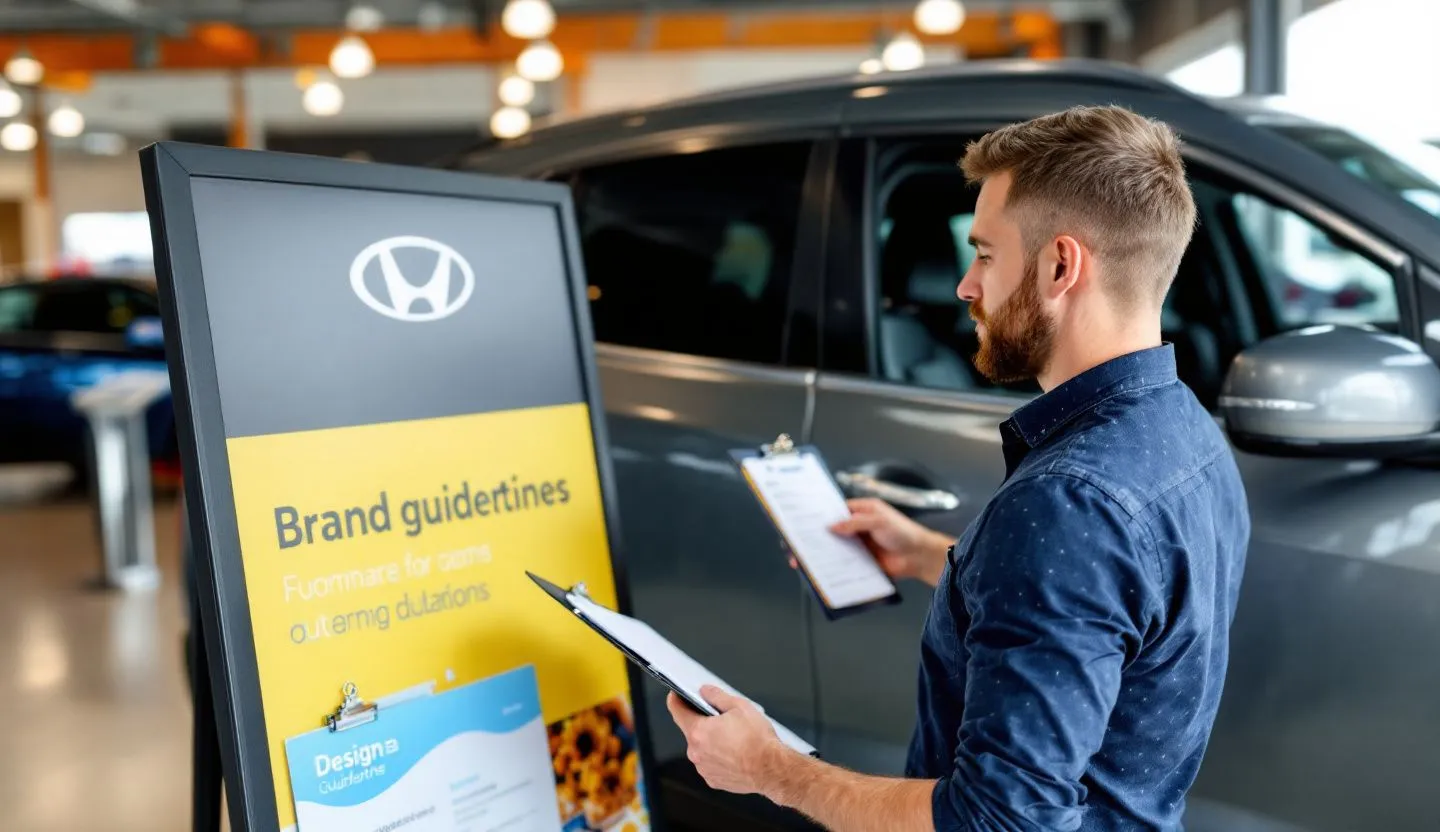When I think back on the last few years in automotive marketing, I see a field where the pressure is relentless and the pace is only accelerating. The tension is real: we’re asked to move fast, scale globally, and personalize every touchpoint,without ever letting the brand’s core promise slip. Every marketing leader in automotive I know feels this. We’re not just keeping up with consumer expectations; we’re sprinting to outpace them, while still threading the needle between compliance, consistency, and creativity.
The pain is familiar: your sales teams crave fresh, localized content. Your legal and compliance partners flag every deviation from brand voice or regulatory guidelines. Meanwhile, IT and operations demand seamless integrations and airtight security. All while you’re trying to build an emotional connection that actually sells cars, not just wins awards. The stakes are enormous, and the margin for error is razor thin.
The real-world pain of automotive branding today
Let’s get honest about where we are. The modern automotive market is crowded, commoditized, and hyper-competitive. Every brand,legacy or challenger,claims performance, reliability, and innovation. The problem isn’t a lack of features or even a shortage of clever campaigns. The real challenge is earning trust at every single touchpoint, from the first Google search to the post-sale email.
I’ve seen the pain firsthand. Regional dealerships want to tailor content to their audiences but risk diluting brand consistency. Partner agencies push the boundaries of creativity, sometimes at the expense of compliance. And let’s not forget the internal hand-offs: brand guidelines get lost in translation between global teams, sales, and local marketing managers. The result? Fragmented messaging, off-brand visuals, and,worst of all,confused customers.
In a field where trust is everything, a single off-brand brochure or an outdated landing page can undo months of relationship-building. And for those of us who live at the intersection of marketing, IT, and compliance, every mistake feels personal.
Why the game is changing for automotive branding
What’s different in 2025? Two things stand out: the digital acceleration of the customer journey, and the expectation that every brand interaction feels seamless, personal, and trustworthy. The old playbook,lead with features, rely on TV spots, print some brochures,just doesn’t cut it.
Today’s buyers are more informed and less loyal. They research online, compare across brands, and expect a frictionless path from inspiration to purchase. And they don’t just judge us against other automakers,they hold us to the standards set by tech, retail, and even streaming services. If your brand touchpoints feel disjointed or outdated, they’ll notice,and move on.
At the same time, the stakes for compliance and security have never been higher. Data privacy rules tighten. Brand risks multiply as content is created and distributed at scale. Meanwhile, the need for speed only grows,especially as new models, EV launches, and global campaigns pile up.
So, how do we build trust, stand out, and actually drive results in this environment? It starts with a new approach to automotive branding,one that’s integrated, adaptive, and built for the realities of 2025.
Building trust at every touchpoint
Trust isn’t something we can bolt on after the fact. It’s built,or broken,at every interaction, from the first digital ad to the in-person dealership experience. For automotive brands, the challenge is making sure every channel, partner, and employee tells a consistent, authentic story.
In my experience, trust is earned through three non-negotiables: clarity, consistency, and transparency. Customers want to know what you stand for,and see it reflected everywhere. That means every campaign, every landing page, every showroom banner needs to reinforce the same message.
Take the launch of a new EV model. The brand promise,sustainability, innovation, reliability,needs to live in the digital configurator, the Instagram ad, the dealer training kit, and the post-purchase survey. If a customer sees one message online but hears a different story in the showroom, trust erodes.
That’s why the most successful automotive brands invest in systems that make it easy for every stakeholder,sales, marketing, partners,to access approved, up-to-date assets. They empower local teams to personalize content, but within clear, auditable guardrails. And they use real-time analytics to spot inconsistencies before they hit the market.
Standing out in a crowded automotive market
Let’s talk about differentiation. In a world where every SUV ad looks the same and every sedan promises “innovation,” standing out isn’t just about louder creative. It’s about having a brand that feels unmistakably yours,at every scale.
This isn’t easy. The urge to play it safe is strong, especially when you’re balancing regulatory requirements, dealer demands, and a global brand platform. But the truth is, sameness is the enemy of growth. If your marketing looks like everyone else’s, you’re just another option in a sea of choices.
What works? I’ve seen brands win by doubling down on their unique story,whether that’s heritage, technology, or customer service,and translating it into every channel. For example, a luxury brand might highlight craftsmanship in everything from social content to in-dealership experiences, while a challenger EV brand might focus on radical transparency and customer empowerment.
The key is making sure your brand DNA is embedded in every asset, not just the hero video. That requires more than a style guide,it needs a system for scalable, on-brand content creation and distribution.
Accelerating speed-to-market without losing control
Here’s the tension I wrestle with every day: how do we move faster,launching new campaigns, updating assets, responding to trends,without losing control of the brand? It’s the question at the heart of every automotive branding strategy conversation I’ve had with peers.
On one hand, our local teams and dealer partners need to react quickly to market shifts,whether it’s a competitor’s price drop or a regulatory change in a specific country. On the other, every new asset is a potential risk: off-brand, non-compliant, or inconsistent.
The old model,centralized, top-down approvals,simply can’t keep up. It leads to bottlenecks, missed opportunities, and frustrated teams. But swinging too far in the other direction means chaos.
The answer lies in empowering teams with the right tools and guardrails. That means:
- Digital asset management with dynamic templates: Local teams can personalize content,think offers, languages, or imagery,while the core design and messaging remain locked. This speeds up execution without sacrificing consistency.
- Automated brand compliance checks: AI-driven systems flag potential issues before assets go live, reducing manual review cycles and ensuring nothing slips through the cracks.
- Seamless integrations with sales and CRM platforms: When content lives where teams already work, adoption goes up and rogue assets go down.
The brands that master this balance don’t just move faster,they actually drive better business outcomes, from higher lead conversion to stronger dealer relationships.
Integrating compliance and risk management into branding
If you’ve ever had a campaign pulled at the last minute due to a missed disclaimer or regulatory misstep, you know how high the stakes are in automotive branding. The cost isn’t just legal,it’s lost time, wasted spend, and a hit to brand credibility.
Compliance can feel like a roadblock, but in 2025, it’s table stakes. The solution isn’t more checklists or heavier approval chains,it’s integrating compliance directly into your marketing workflows.
What does this look like in practice? For one global automotive brand I worked with, we built a system where every asset,digital, print, or social,ran through an automated compliance engine. This scanned for required language, checked for outdated incentives, and flagged regional restrictions before anything reached the market.
The result was transformative. Not only did we reduce compliance errors by over 70%, but we also freed up our creative and legal teams to focus on higher-value work. Most importantly, we built a culture where compliance and creativity worked hand in hand, not at odds.
The role of technology in modern automotive branding
Let’s get practical: none of these strategies work without the right technology foundation. In 2025, the most effective automotive brands rely on integrated, enterprise-grade platforms that connect creative, compliance, and content distribution.
But choosing the right stack isn’t about chasing the latest buzzword. It’s about solving real problems: speeding up asset creation, ensuring brand control, and reducing risk. For me, the best solutions are those that:
- Centralize approved assets and templates: Everyone,from the CMO to the local dealer,works from a single source of truth. This eliminates version control nightmares and rogue creative.
- Offer granular user permissions: Differentiate between what a dealer, agency partner, or field marketer can edit, ensuring compliance and brand safety.
- Automate reporting and analytics: Real-time insights help us spot what’s working (and what’s not), so we can optimize on the fly.
- Integrate with existing enterprise systems: Whether it’s CRM, DAM, or compliance software, seamless connections reduce manual work and data silos.
A great example is how one European automaker connected its content platform with both sales enablement and legal review tools. The result? Faster campaign launches, fewer compliance headaches, and a measurable lift in brand perception across key markets.
Personalization at scale: Meeting the demands of modern buyers
Personalization is no longer a nice-to-have,it’s a necessity. Today’s automotive buyers expect offers, content, and experiences tailored to their needs, interests, and location. But for enterprise brands, personalization at scale brings real challenges: how do you enable local relevance without creating chaos?
The answer lies in systematized flexibility. I’ve seen success when brands build modular content systems,think dynamic templates, localizable assets, and rule-based personalization. This lets regional teams swap in relevant offers or languages, while the core brand story stays intact.
For example, during a recent EV launch, we equipped local dealers with customizable digital ads and email templates. Each could tweak the offer or CTA, but the imagery, logo, and key messaging were locked. The impact? Higher engagement, faster execution, and zero off-brand surprises.
Personalization isn’t just about technology, though. It requires a mindset shift: trusting your teams, providing clear guidelines, and supporting them with ongoing training.
Creating a culture of brand stewardship
Technology and systems matter, but at the end of the day, automotive branding is powered by people. The most successful organizations foster a culture where everyone,from creative directors to dealer sales staff,feels responsible for protecting and advancing the brand.
This doesn’t happen by accident. It takes intentional effort:
- Regular brand training: Not just at onboarding, but ongoing, with real-world scenarios and practical tips for every role.
- Transparent feedback loops: Make it easy for local teams to flag challenges, share what’s working, and surface opportunities for improvement.
- Recognition and incentives: Celebrate teams and individuals who go above and beyond in delivering on-brand, compliant, and creative work.
I’ve seen firsthand how a culture of brand stewardship turns branding from a checklist into a competitive advantage. When everyone feels ownership, consistency and creativity thrive,even as the pace picks up.
Measuring what matters: Proving the ROI of automotive branding
As marketing leaders, we know that what gets measured gets managed. But automotive branding has long been seen as a “soft” metric,hard to quantify, easy to deprioritize. That’s changing.
Today, the best brands tie branding efforts directly to business outcomes. We’re not just tracking impressions or awareness; we’re measuring lift in lead quality, dealer engagement, customer retention, and lifetime value.
A few ways to connect the dots:
- Closed-loop reporting: Integrate branding analytics with sales and CRM data to see how on-brand assets drive real business results.
- Brand health surveys: Regularly track perception across key markets and segments, linking shifts to specific campaigns or touchpoints.
- Compliance and risk metrics: Quantify reductions in errors, regulatory issues, or legal interventions as a direct outcome of improved branding processes.
For example, after standardizing content creation and distribution, one US automaker saw a 20% increase in dealer satisfaction scores and a measurable uptick in brand trust among consumers. When branding is done right, the results speak for themselves.
Future trends in automotive branding for 2025 and beyond
Looking ahead, a few trends will define the next era of automotive branding. First, the rise of AI and automation will make content creation faster and more adaptive,but only brands with strong governance will avoid the pitfalls of inconsistency or “robotic” messaging.
Second, sustainability and social responsibility will move from the periphery to the core of brand strategy. Buyers want to see authentic action, not just greenwashing, reflected in every asset and experience.
Third, the line between physical and digital will continue to blur. Dealerships will become experience centers, while online platforms will offer richer, more immersive journeys. The brands that win will be those that create a seamless, emotionally resonant story,regardless of channel.
Finally, the need for speed, security, and scalability will only grow. Enterprise marketers must future-proof their branding operations with platforms and processes built for rapid change.
The path to effective automotive branding in 2025 isn’t paved with one-off campaigns or siloed creative teams. It’s built on a foundation of trust, consistency, and agility,enabled by technology, but powered by people. As enterprise marketing leaders, we have a unique opportunity (and responsibility) to champion systems that let us move fast without breaking the brand, deliver personalization without chaos, and integrate compliance without slowing down.
What stands out to me is this: the brands that win are those that see automotive branding not as a cost center, but as a driver of measurable business value. By aligning marketing, IT, compliance, and operations around a common goal,and giving every team the tools and guardrails to succeed,we can build brands that not only stand out, but truly earn trust at every touchpoint.
As we look to 2025 and beyond, the challenge isn’t just to keep up,it’s to set the pace. By investing in integrated platforms, nurturing a culture of brand stewardship, and never losing sight of the customer, we can create automotive branding strategies that don’t just sell cars, but build lasting relationships and drive long-term results. Let’s make the brand the engine of growth, not just the paint job.







